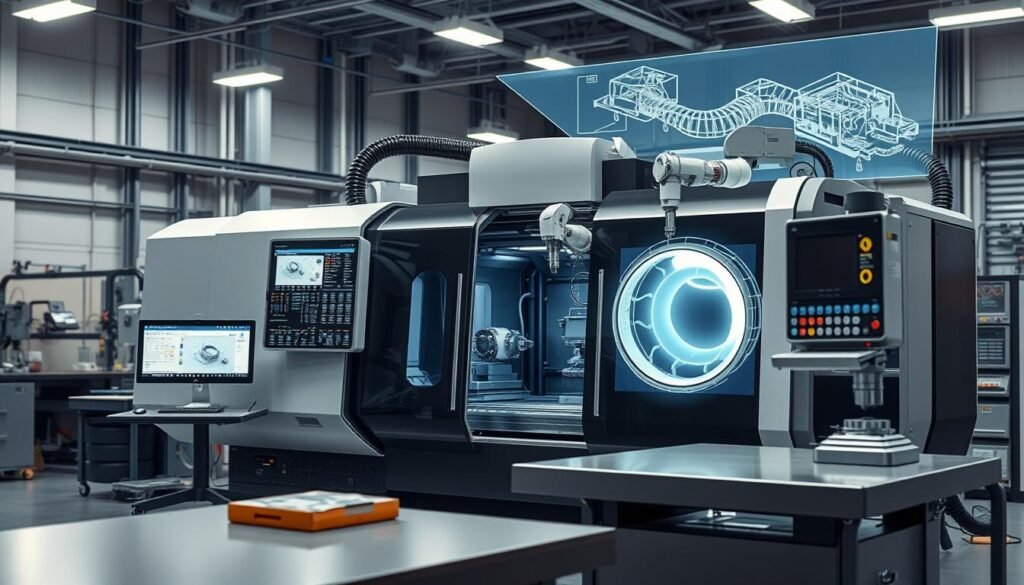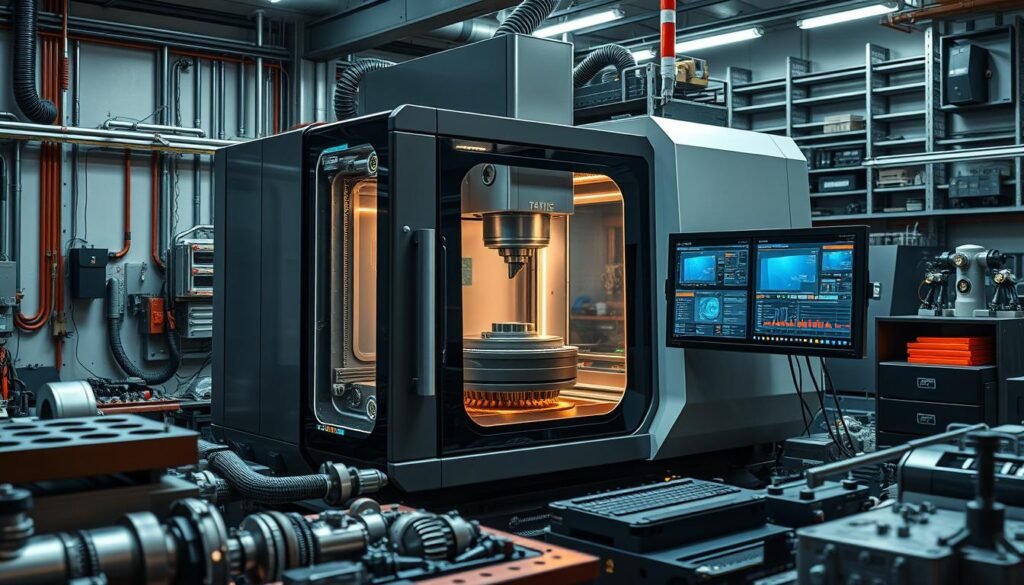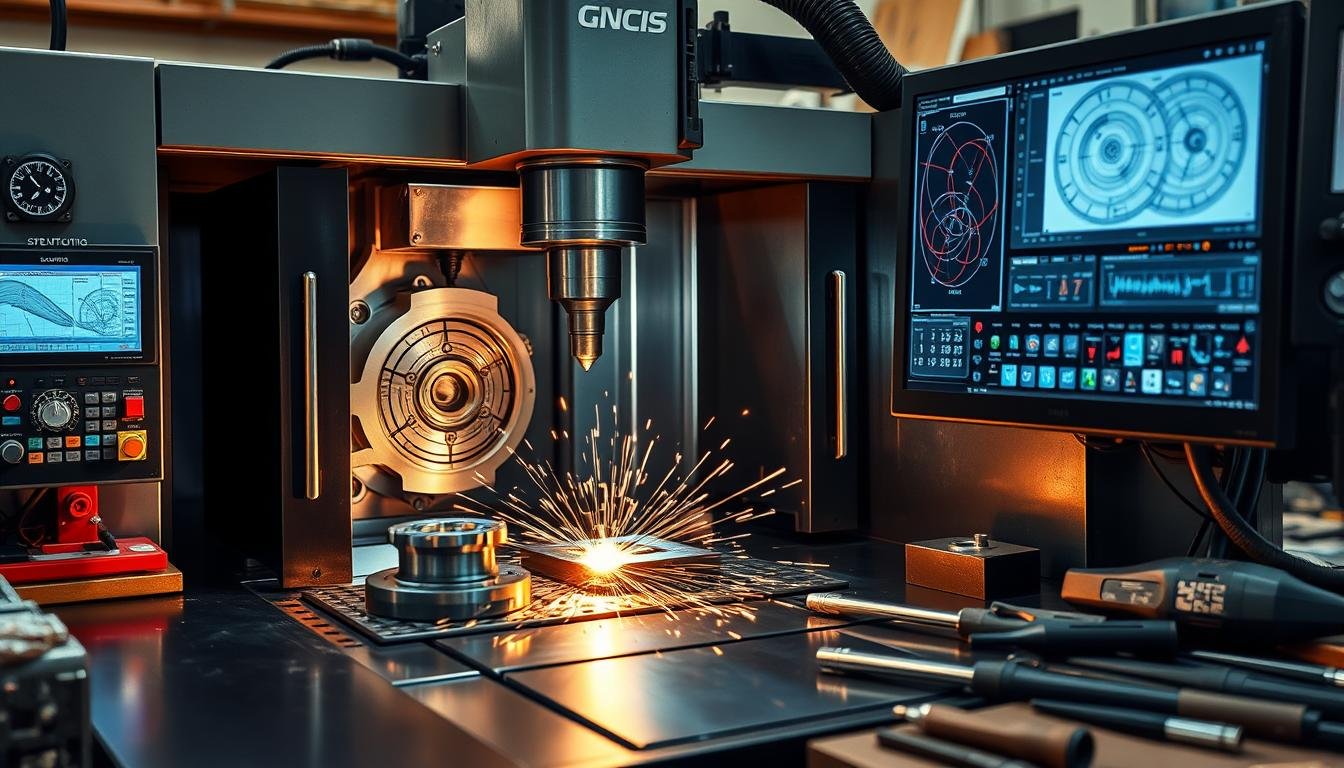Вы когда-нибудь задумывались над тем, как выглядят мелкие детали в повседневных товарах? Как G-код превратить металл в точные детали? Секрет в Программирование станков с ЧПУ. Это умение сочетает в себе компьютерное управление и прочность материалов. Это важная часть современного мира производства. Давайте узнаем, как стать квалифицированным специалистом в области программирования ЧПУ и какова его роль в производстве вещей.
Знание правильного метода программирования является ключевым для всех, кто работает со станками. Это включает в себя ручное, разговорное программирование или программирование в системе CAM. Если вы работаете над деталями для самолетов, автомобилей или предметов повседневного обихода, умение хорошо общаться со станками с ЧПУ имеет решающее значение. Использование G-код и правильный M-код означает переход от просто хорошего к отличному в вашей работе.
Основные выводы
- G-код: Основной язык станков с ЧПУ, позволяющий выполнять точную обработку.
- Ручное, разговорное и CAM-программирование: Три основных метода программирования ЧПУ, каждый из которых обладает особыми преимуществами.
- Функции М-кода: Важны для управления частями станка с ЧПУ, например, вращением шпинделя.
- Черчение кривых в ЧПУ: создание программ для кривых и окружностей с прямыми линиями для идеального дизайна.
- Консервированные циклы: Заданные последовательности действий ускоряют обработку отверстий и уменьшают количество ошибок.
- Компенсационные техники: Регулировка длины инструмента и радиуса фрезы для достижения максимальной точности ЧПУ.
- Индивидуальное обучение: Курсы программирования на станках с ЧПУ позволяют повысить квалификацию примерно за 100 часов, сочетая теорию и практику.
Понимание обработки с ЧПУ: Основные принципы
Обработка на станках с ЧПУ сочетает в себе технологию и точность для создания сложных деталей. Она опирается на Программное обеспечение для ЧПУ, траектории инструментови программы. Эти элементы улучшают работу и контроль качества.
Роль G-кода и M-кода в системе ЧПУ
G-код и M-код имеют решающее значение для станков с ЧПУ. G-код управляет движениями станка для изготовления точных деталей. М-код решает такие задачи, как запуск или остановка шпинделя. Они обеспечивают точность и последовательность операций, повышая производительность и качество.
Ручное программирование против разговорного программирования против программирования в CAM-системе
Различные стили программирования ЧПУ влияют на эффективность и качество. Ручное программирование предполагает прямой ввод G-кода, что обеспечивает контроль, но требует навыков. Разговорное программирование использует интерактивный интерфейс для упрощения работы.
Программирование в CAM-системах является наиболее продвинутым и использует программное обеспечение для автоматизации создания траектории инструмента. Это позволяет сократить количество ошибок и справиться со сложными конструкциями. CAM-системы позволяют программировать несколько операций, оптимизируя процесс для сложных установок.
В таблице ниже приводится сравнение этих трех типов программ по основным операционным показателям:
| Тип программирования | Обработка сложности | Удобство для пользователя | Гибкость | Типовые применения |
|---|---|---|---|---|
| Руководство | Низкий | Низкий | Высокий | Простые детали, быстрые модификации |
| Разговорный | Средний | Высокий | Средний | Прототипирование, мелкосерийное производство |
| Система CAM | Высокий | Средний | Низкий | Сложные детали, крупномасштабное производство |
От изучения G-кода до использования программного обеспечения CAM, обработка на станках с ЧПУ является передовой и разнообразной. Эти знания улучшают работу станка, повышают адаптивность и производительность производства.
Основные навыки программирования на станках с ЧПУ для успеха
Чтобы овладеть основами программирования ЧПУ, требуются глубокие знания и практические навыки. Очень важно знать язык программирования используемые в ЧПУ, такие как G-коды и M-коды. Они помогают выполнять задачи с высокой точностью и решать проблемы для Машинисты с ЧПУ.
Машинисты с ЧПУ необходимо научиться создавать эффективные стратегии траектории инструмента. Они должны понимать материалы, формы и принцип работы станков с ЧПУ. Благодаря этим знаниям станки с ЧПУ выдают правильные результаты.
Получение правильного образования - ключ к приобретению этих навыков. Многие программисты с ЧПУ начинают с получения аттестата о среднем образовании, затем проходят курсы в профессиональных училищах или муниципальных колледжах. Эти курсы посвящены математике, программному обеспечению CAD/CAM и основам механической обработки.
| Образование | Развитие ключевых навыков | Применение в промышленности |
|---|---|---|
| Профессиональное обучение работе на станках с ЧПУ | Геометрия, тригонометрия, знание САПР | Работа на мельнице, чтение чертежей |
| Степень младшего специалиста или сертификация | Расширенное программирование, настройка оборудования | Многоосевая обработка, программирование CAM |
| Обучение на рабочем месте | Поиск и устранение неисправностей, контроль качества | Изготовление на заказ, производство компонентов |
Решение проблем, критическое мышление и анализ ситуаций - важнейшие навыки. Они помогают быстро исправлять ошибки в обработке и повышать производительность. Очень важно оставаться в курсе последних достижений в области ЧПУ благодаря практике и обучению.
Обучение язык программирования Синтаксис, работа с инструментами, управление скоростью и скорости подачи является частью комплексного обучения. Эта подготовка закладывает прочный фундамент для успешного программиста с ЧПУ, что приводит к новым инновациям и повышению эффективности производства.
Потребность в квалифицированных программистах с ЧПУ растет по мере того, как технологии приобретают все большее значение в промышленности. Овладение основами программирования ЧПУ не только способствует карьере машиниста, но и стимулирует инновации и рост в отрасли.
Методы программирования ЧПУ: Сравнительный обзор
Рассматривая различные методы программирования ЧПУ, мы видим значительные изменения в Технологии ЧПУ. В основном изменения происходят от ручных процессов к автоматизированным. Это дает более четкое представление о том, как работает каждый метод в отношении эффективность программированияНасколько они просты в использовании и насколько хорошо они адаптируются к реальным условиям производства.
Ручное программирование и его значение
Ручное программирование имеет решающее значение для отраслей, где требуется высокая точность и индивидуальная работа. Оно лучше всего подходит для работ с большим количеством деталей, позволяя операторам настраивать станки для точных разрезов. Но, несмотря на то, что этот способ дешевле, он требует квалифицированных программистов и хорошо подходит только для простых форм.
Исследование эффективности разговорного программирования
Разговорное программирование облегчает Операторы ЧПУ для создания программ на самих машинах. Благодаря графическому интерфейсу, основанному на меню, он не требует длительного обучения. Он отлично подходит для быстрой работы с более простыми формами, повышая скорость производства.
Расширенные возможности систем CAM
CAM-системы - это высокотехнологичные решения, позволяющие сделать программирование ЧПУ более плавным. Интерфейс CAM. Эти системы справляются со сложными формами лучше, чем ручные методы. Они хорошо работают с проектами CAD, позволяя автоматизировать изготовление сложных деталей. От начала до конца Интерфейс CAM помогает повысить эффективность программирования много.

| Характеристика | Ручное программирование | Разговорное программирование | Программирование системы CAM |
|---|---|---|---|
| Время и ресурсоемкость | Высокий | Умеренный | Низкий |
| Зависимость от навыков | Высокий | Умеренный | Низкий |
| Поддержка сложных геометрий | Ограниченный | Ограниченный | Обширный |
| Экономическая эффективность | Высокий | Умеренный | Переменная |
| Подходящий объем | Большой объем | Средний объем | Любой объем |
В конце концов, независимо от того, используется ли ручной, разговорный или CAM-системаУ каждого подхода есть свои плюсы и минусы. Знание их помогает компаниям улучшить рабочий процесс, идеально сочетая технологии и навыки.
Стратегии оптимизации при программировании ЧПУ
В программировании ЧПУ использование передовых стратегий оптимизации является ключевым моментом. Это приводит к повышению точности программирования и настройки станка. Это повышает Эффективность проектов с ЧПУ и оптимизация производства. Он также помогает предотвратить поломка инструмента.
Главное - использовать разные траектории инструментов для различных операций обработки. Это влияет на скорости подачи и эффективность машины.
Эффективно структурированные алгоритмы траектории движения инструмента вносят значительный вклад в сокращение машинного времени и повышение производительности.
Максимальное повышение эффективности благодаря точным регуляторам скорости и подачи
Установите правильную скорость и скорости подачи имеет решающее значение для оптимизации производственные процессы. Траектории инструментов такие как Spiral и Radial, обеспечивают постоянное зацепление инструмента. Они также контролируют температуру обработки, что помогает инструментам служить дольше и меньше изнашиваться.
Регулировка смещения инструмента и приспособления для обеспечения точности
Корректировка смещений инструментов и приспособлений значительно повышает точность деталей. Сглаживание траектории инструмента и контурная обработка обеспечивают лучший контроль. Это приводит к получению более гладких поверхностей и более точных размеров.
| Тип траектории инструмента | Описание | Ключевое преимущество |
|---|---|---|
| Траектория инструмента зиг-заг | Идеально подходит для обработки карманов и профилирования | Минимизирует втягивание инструмента, оптимизируя эффективность резки |
| Радиальная траектория инструмента | Подходит для обработки цилиндрических и контурных поверхностей | Обеспечивает постоянное зацепление инструмента, плавный съем материала |
| Спиральная траектория инструмента | Эффективна для высокоскоростной обработки глубоких полостей | Минимизирует износ инструмента, сокращая время обработки |
| Параллельная траектория инструмента | Оптимизация расстояния между траекториями инструментов на плоских поверхностях | Минимизирует перекрытие, повышая эффективность обработки |
| Адаптивный клиринг | Использует алгоритмы динамической траектории инструмента | Поддерживает постоянную силу резания, минимизируя износ инструмента |
Благодаря точному контролю и настройкам каждая задача ЧПУ становится более точной и эффективной. Такие стратегии адаптации, как радиальный и спиральные траектории инструментов В соответствии с различными потребностями повышает производительность и устойчивость производства.
Программирование на станках с ЧПУ: Советы по точности и эффективности
При программировании ЧПУ достижение точность изготовления и эффективность имеют решающее значение. Для этого необходимо овладеть несколькими важными приемами. К ним относятся эффективные советы по улучшению как проектирования, так и производства. Современные станки с ЧПУ нуждаются в точных инструкциях для достижения максимальной производительности и снижения количества отходов.
Для лучшего точность изготовленияПрограммисты используют такие приемы, как подпрограммы и макросы. Эти методы облегчают чтение и управление G-кодом. Они также повышают производительность машин. Добавление технологий искусственного интеллекта и ML позволило повысить эффективность программирования за счет улучшения калибровки и исправления ошибок.
Качественное программное обеспечение CAM также играет большую роль. Такие инструменты, как Autodesk Fusion 360, Mastercam и SolidCAM, обладают широкими возможностями. Например, адаптивная очистка ускоряет удаление материала и защищает инструменты. Это позволяет сократить время производства и уменьшить количество неиспользованных материалов - ключевые задачи для эффективные тактики программирования.
Вот краткий список важных стратегий и инструментов в программировании ЧПУ. Они помогают повысить точность и эффективность:
| Стратегия | Инструмент или функция | Выгода |
|---|---|---|
| Расширенная калибровка | Интеграция ИИ и ОД | Сокращает количество человеческих ошибок и автоматизирует настройки |
| Подпрограммы и макросы | Расширенные возможности G-кода | Повышает ремонтопригодность и упрощает эксплуатацию |
| Адаптивный клиринг | Autodesk Fusion 360 и Mastercam | Повышает съем материала и долговечность инструмента |
| Моделирование | ВЕРИКУТ И НЦИМУЛ | Предотвращает ошибки и повышает точность программы |
Успех программирования ЧПУ зависит и от программиста. Постоянное обучение и использование новых методов очень важны. Это позволяет поддерживать остроту навыков и способствует инновациям в программировании ЧПУ.
В связи с постоянными изменениями в сфере производства необходимо быть в курсе последних событий. эффективные тактики программирования является жизненно важным. Использование этих инструментов и методов позволит программированию ЧПУ оставаться в авангарде промышленных технологий.
Передовые методы программирования ЧПУ
В мире обработки на станках с ЧПУ изучение передовых методов повышает производительность и точность. Мы рассматриваем ключевые стратегии, в которых используются новейшие технологии ЧПУ.
Внедрение циклов консервирования для повышения производительности
Консервированные циклы облегчают программирование ЧПУ. Они упрощают кодирование и ускоряют процесс обработки. Это сокращает время программирования и количество ошибок. G-коды, такие как G81 для сверления и G83 для сверления пека, автоматизируют повторяющиеся задачи. Это повышает эффективность. Вам нужно ввести всего несколько параметров, таких как начальная и конечная точки и глубина отверстий. Это очень удобно при изготовлении большого количества изделий.
Методы компенсации для учета переменных параметров машины
Компенсация механической обработки помогает справиться с переменными, влияющими на точность. Такие методы, как компенсация длины инструмента и компенсация радиуса фрезы, очень важны. Они позволяют точно настроить обработку для обеспечения точности. Эти регулировки помогают при изменении конструкции инструмента, износе и проблемах с настройкой. Использование этих методов означает, что продукция соответствует жестким стандартам точности, несмотря на все эти трудности.
Например, код G96 поддерживает постоянную скорость резания при токарных работах для равномерного съема материала. Знание того, как регулировать частоту вращения шпинделя и скорость подачи, также помогает. Это предотвращает ошибки и укрепляет процесс обработки.

| Техника | Выгода | Общие приложения |
|---|---|---|
| Консервированные циклы | Повышение производительности, снижение количества ошибок | G81, G83 в сверлении, G17 во фрезеровании |
| Компенсация механической обработки | Повышенная точность, регулировка износа инструмента | Регулировка длины инструмента при различных операциях |
Использование передовых методов повышает эффективность и опыт. Это готовит программистов ЧПУ к сложным ситуациям. Они могут предоставлять высококачественную и точную продукцию, являясь лидерами в области инноваций в сфере ЧПУ.
Важность математики в программировании ЧПУ
При обработке на станках с ЧПУ использование математики не просто полезно, а крайне важно. Точность в производстве с ЧПУ во многом зависит от математическая точность. Каждый срез и изгиб - результат расчетов, которые делают дизайн реальным.
Программирование расчетов являются ключевыми в работе с ЧПУ. Такие станки, как фрезеры и маршрутизаторы, изготавливают детали с высочайшей точностью. Они выполняют команды, основанные на сложной математике, чтобы соответствовать высоким стандартам качества.
Обеспечение точности расчетов для получения качественных результатов
Программирование ЧПУ требует пристального внимания к точным измерениям. Неправильные расчеты могут привести к большим ошибкам в производстве. Например, для расчета числа оборотов используется формула: RPM = SFPM x 3,82 / Диаметр инструмента. Эти расчеты обеспечивают эффективность и качество продукции.
Программирование кривых и углов с математической точностью
Для изготовления таких сложных деталей, как шестеренки, программирование должно быть точным. Математическая точность в ЧПУ имеет решающее значение. Используя математику, станки с ЧПУ могут точно создавать эти детали. Этот навык жизненно важен в таких областях, как аэрокосмическая промышленность и здравоохранение.
Математика является ключевым элементом в программировании ЧПУ для достижения высокого качества качественное производство с ЧПУ. По мере совершенствования технологий ЧПУ растет потребность в точной математике. Это показывает, насколько важна математика для программистов ЧПУ.
От новичка к эксперту: оттачиваем навыки программирования ЧПУ
Переход от новичка к эксперту в программировании ЧПУ требует упорного труда и постоянного обучения. Мир технологий ЧПУ постоянно меняется. Поэтому совершенствование своих навыков жизненно важно для вашего карьерного роста.
Структурированное обучение и практика в реальных условиях очень важны для совершенствования. Существует множество курсов, начиная с основ и заканчивая сложными темами. Эти возможности очень важны для постоянного совершенствования в Развитие навыков работы с ЧПУ.
Эффективные методы непрерывного обучения и совершенствования
Быть в курсе потребностей отрасли и новых технологий очень важно. Это означает посещение официальных курсов и самостоятельное обучение. Получение таких сертификатов, как "Оператор ЧПУ" или "Программист ЧПУ", создает прочную базу. Технические дипломы дают более глубокие знания.
Использование симуляционного программного обеспечения для повышения квалификации
Моделирующее программное обеспечение - лучший способ улучшить навыки программирования ЧПУ. Такие платформы, как Autodesk, помогают пользователям безопасно опробовать реальные проекты. Такой подход обеспечивает прямую обратную связь и практическое обучение, что очень полезно для совершенствования.
Очень важно постоянно осваивать новые навыки. По мере Развитие навыков работы с ЧПУ Мир растет, и профессионалы тоже. Постоянное обучение и упорный труд - залог успешной карьеры в области программирования ЧПУ.
Заключение
Освоение программирования ЧПУ - это больше, чем просто практика. Речь идет о стремлении к совершенству в этой отрасли. Понимание G-кода и ручного программирования помогает развивать навыки. У каждого из них есть свои плюсы и минусы. Разговорное программирование легко для обучающихся. CAM-программирование позволяет работать со сложными формами и делает работу повторяемой.
Автоматизация, как и CAM, повышает эффективность программирования ЧПУ. Но она стоит дорого и требует специалистов-программистов. Ultirapid полагается на CAM благодаря его передовым технологическим преимуществам. Программирование на станках с ЧПУ играет большую роль в таких важных областях, как аэрокосмическая промышленность и здравоохранение. Оно способствует инновациям и совершенству. Навыки программистов с ЧПУ необходимы для успеха.
Чтобы быть впереди, производители должны сотрудничать с экспертами. Такие партнеры предлагают знания, технологии и обучение. Промышленность постоянно меняется, и спрос на квалифицированных специалистов тоже. Успех в программировании ЧПУ означает адаптацию, обучение на каждом производстве и обмен знаниями. Речь идет о том, чтобы поднять весь производственный мир.
ЧАСТО ЗАДАВАЕМЫЕ ВОПРОСЫ
Что такое программирование ЧПУ и как оно влияет на точность обработки?
Программирование ЧПУ создает инструкции для станков с ЧПУ по изготовлению деталей. Оно помогает прецизионная обработка точно направляя инструменты. Это обеспечивает соответствие деталей необходимым спецификациям.
Можете ли вы объяснить роль G-кода и M-кода в системе ЧПУ?
G-код задает станкам с ЧПУ движения для изготовления детали. Он задает позиции и скорости. М-код управляет такими задачами, как запуск шпинделя. Оба кода являются ключевыми для работы ЧПУ.
В чем разница между ручным, разговорным и CAM-программированием?
Ручное программирование - это самостоятельное написание G-кода. Он требует глубокого понимания, но для достижения лучших результатов его нужно подправить. Разговорное программирование проще, с использованием меню. Оно помогает избежать проблем с CAM.
Программирование CAM использует графику для создания траекторий инструментов. Это сокращает ручной труд и делает работу более плавной.
Какие базовые навыки программирования ЧПУ необходимы для машиниста?
Машинисты должны хорошо знать языки программирования. Создание эффективных траекторий движения инструментов и точные математические расчеты имеют решающее значение. Эти навыки обеспечивают точность программ ЧПУ для различных работ.
Как ручное программирование способствует повышению точности обработки на станках с ЧПУ?
При ручном программировании операторы используют свои ноу-хау для практического управления. Такая гибкость позволяет точно настраивать программы CAM. Это приводит к повышению точности.
В чем преимущества разговорного программирования?
Разговорное программирование удобно для пользователя благодаря графике и меню. Оно позволяет операторам быстро настраивать детали программы, сокращая количество проблем с постпроцессором CAM.
Как CAM-системы улучшают программирование станков с ЧПУ?
Системы CAM предлагают сложный графический интерфейс. Он помогает подготовить сложные траектории движения инструментов для более рационального программирования. В результате получаются эффективные и автоматизированные инструкции для станков.
Почему оптимизация скорости и подачи важна при программировании ЧПУ?
Правильная скорость и скорости подачи делают программирование ЧПУ эффективным. Они помогают получать детали хорошего качества. Их правильная настройка снижает износ инструмента и уменьшает количество ошибок, например, поломки инструмента.
Какую роль играют смещения инструментов и приспособлений в точности производства?
Смещение регулирует износ инструмента, длину и положение приспособлений. Эти корректировки жизненно важны для изготовления деталей с ЧПУ, отвечающих строгим требованиям к точности производства.
Как повысить точность и эффективность программирования ЧПУ?
Чтобы стать лучше, хорошо изучите основы, проверяйте свои математические вычисления и корректируйте программы для каждого проекта. Знание пределов программного обеспечения для ЧПУ помогает вносить изменения вручную при изготовлении сложных или точных деталей.
Что такое консервированные циклы и как они повышают производительность ЧПУ?
Консервированные циклы - это заданные шаблоны для повторяющихся задач, например сверления. Просто введите ключевые данные для каждого отверстия. Это повышает производительность и сокращает количество ошибок.
Почему компенсация важна и какие методы используются при программировании ЧПУ?
Компенсация корректирует изменения в станке, которые могут привести к изменению размеров деталей. Техники корректируют размер инструмента, его износ и положение приспособлений. Это обеспечивает точность обработки.
Как математическая точность влияет на программирование ЧПУ?
Точные математические расчеты обеспечивают правильные размеры и формы деталей. Это ключ к правильному управлению станком, особенно при обработке сложных кривых и углов.
Какие стратегии могут помочь начинающему программисту ЧПУ стать **экспертом**?
Начните с обучения на курсах, применения полученных знаний и использования программ для моделирования. Такие ресурсы, как Instructables и Autodesk, тоже помогут. Практика и постоянное любопытство сделают вас экспертом.
Как постоянное повышение квалификации влияет на навыки программирования ЧПУ?
Постоянное обучение позволяет вам быть в курсе достижений в области ЧПУ и совершенствовать свои навыки. Это поможет вам оставаться конкурентоспособными и соответствовать развивающимся стандартам отрасли.


